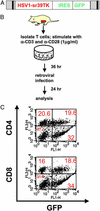Quantitative imaging of the T cell antitumor response by positron-emission tomography
- PMID: 12547911
- PMCID: PMC298756
- DOI: 10.1073/pnas.0337418100
Quantitative imaging of the T cell antitumor response by positron-emission tomography
Abstract
We describe a noninvasive, quantitative, and tomographic method to visualize lymphocytes within the whole animal. We used positron-emission tomography (PET) to follow the localization of adoptively transferred immune T lymphocytes. Splenic T cells from animals that had rejected a Moloney murine sarcoma virus/Moloney murine leukemia virus (M-MSV/M-MuLV)-induced tumor were marked with a PET reporter gene, injected into tumor-bearing mice, and imaged in a microPET by using a substrate specific for the reporter. Specific localization of immune T cells to the antigen-positive tumor was detected over time, by sequential imaging of the same animals. Naive T cells did not localize to the tumor site, indicating that preimmunization was required. Autoradiography and immunohistochemistry analysis corroborated the microPET data. The method we have developed can be used to assess the effects of immunomodulatory agents intended to potentiate the immune response to cancer, and can also be useful for the study of other cell-mediated immune responses, including autoimmunity.
Figures






References
-
- Schreiber H. In: Fundamental Immunology. Paul W E, editor. Philadelphia: Lippincott-Raven; 1999. pp. 1237–1270.
-
- Rosenberg S A. Nature. 2001;411:380–384. - PubMed
-
- Ross J S, Sheehan C E, Fisher H A, Kauffman R A, Dolen E M, Kallakury B V. Expert Rev Mol Diagn. 2002;2:129–142. - PubMed
-
- Gambhir S S. Nat Rev Cancer. 2002;2:683–693. - PubMed
Publication types
MeSH terms
Substances
Grants and funding
LinkOut - more resources
Full Text Sources
Other Literature Sources

